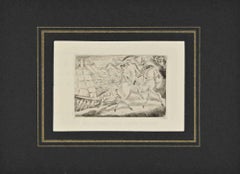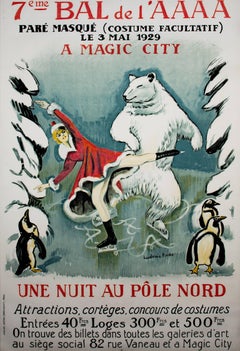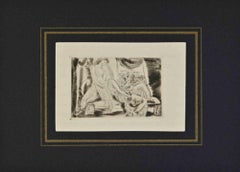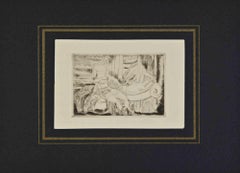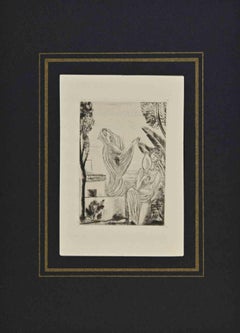Early 20th Century Figurative Prints
to
594
2,435
541
252
80
81
Overall Width
to
Overall Height
to
1,400
283
244
143
125
37
25
21
3
2
1
1
170
102
59
56
43
3,642
7,765
25,317
6,669
285
583
1,459
1,206
1,250
2,193
3,069
5,178
3,016
1,519
3,110
2,379
989
19
2,743
1,486
1,333
1,075
827
807
557
287
203
178
173
163
153
141
125
124
117
82
72
60
1,159
1,123
599
450
365
340
1,257
1,553
1,317
Period: Early 20th Century
The Dream - Etching by A. Suares - 1926
Located in Roma, IT
The Dream is from Illustrations for Cressidra, a print on paper realized by André Suares in 1926.
Etching and drypoint
Edition of 200 print, Including a Passepartout
Good conditi...
Category
Symbolist Early 20th Century Figurative Prints
Materials
Drypoint, Etching
Lovers on Horse - Etching by A. Suares - 1926
Located in Roma, IT
Lovers on Horse from Illustrations for Cressidra, is a print on paper realized by André Suares in 1926.
Etching and drypoint
Edition of 200 print. Including a Passepartout.
Good ...
Category
Symbolist Early 20th Century Figurative Prints
Materials
Drypoint, Etching
"7Eme Bal de l'AAAA Skater, " Original Lithograph Poster by Ludovic Rodo Pissarr
Located in Milwaukee, WI
"7Eme Bal de l'AAAA Skater" is an original color lithograph poster by Ludovic Rodo Pissarro. The artist signed the piece in plate lower right. It depicts a wo...
Category
Modern Early 20th Century Figurative Prints
Materials
Lithograph
Lovers - Etching by André Suares - 1926
Located in Roma, IT
Lovers is from Illustrations for Cressidra, a print on paper realized by André Suares in 1926.
Etching and drypoint
Edition of 200 print, Including a Passepartout
Good conditions.
Category
Symbolist Early 20th Century Figurative Prints
Materials
Etching
Lovers - Etching by André Suares - 1926
Located in Roma, IT
Lovers is from Illustrations for Cressidra, a print on paper realized by André Suares in 1926.
Etching and drypoint
Edition of 200 print, Including a Passepartout
Good conditions.
Category
Symbolist Early 20th Century Figurative Prints
Materials
Etching
Ladies - Etching by André Suares - 1926
Located in Roma, IT
Ladies is from Illustrations for Cressidra, a print on paper realized by André Suares in 1926.
Etching and drypoint
Edition of 200 print, Including a Passepartout
Good conditions.
Category
Symbolist Early 20th Century Figurative Prints
Materials
Etching
Landscape - Etching by André Suares - 1926
Located in Roma, IT
The Landscape is from Illustrations for Cressidra, a print on paper realized by André Suares in 1926.
Etching and drypoint
Edition of 200 print, Including a Passepartout
Good con...
Category
Symbolist Early 20th Century Figurative Prints
Materials
Etching
The Lady and Mirror - Etching by A. Suares - 1926
Located in Roma, IT
The Lady and Mirror is from Illustrations for Cressidra, a print on paper realized by André Suares in 1926.
Etching and drypoint
Edition of 200 print, Including a Passepartout
G...
Category
Symbolist Early 20th Century Figurative Prints
Materials
Etching
LEANING ON THE WALL
Located in Portland, ME
Bishop, Isabel. LEANING ON THE WALL. Teller 4. Etching, 1927. A rare Proof printed by the artist; there was no edition of this print. Signed in pencil, lower right, and inscribed "Li...
Category
Early 20th Century Figurative Prints
Materials
Etching
Loading Vraic St. Malo
Located in New York, NY
Edmund Blampied (1886-1966), Loading Vraic St. Malo, drypoint, c. 1926, signed in pencil lower right margin and numbered 50/100 lower left. Reference: Appleby 122. In very good condition, with margins, on an ivory laid paper; 6 7/8 x 10, the sheet 10 x 15 1/2 inches, archival mounting.
A fine impression, with substantial burr from the drypoint work.
Provenance: Collection: Albert M...
Category
Realist Early 20th Century Figurative Prints
Materials
Drypoint
Stage Design - Phototype after Sergei Eisenstein - 1920s
Located in Roma, IT
Stage Design is a modern artwork realized after Sergei Eisenstein in the mid-20th century.
Mixed colored phototype print.
Includes frame: 44 x 33 cm
Fair conditions due to the tim...
Category
Contemporary Early 20th Century Figurative Prints
Materials
Photogravure
Personnages Constructiviste - Mixed Media by Antonina Sofronova - 1920s
Located in Roma, IT
Personnages Constructivistes Assises is a modern artwork realized by Antonina Sofronova between 1920-30s.
Mixed Media on Paper.
Includes frame: 48.5 x 34.5 cm
Antonina Sofronova ...
Category
Contemporary Early 20th Century Figurative Prints
Materials
Lithograph
Princess Turandot - Phototype after Ignatius I. Nivinsky - 1922
Located in Roma, IT
Princess Turandot is a modern artwork realized after Ignatius Ignatievich Nivinsky in the mid-20th century.
Mixed colored phototype print..
Set design for the fairy tale Princess ...
Category
Contemporary Early 20th Century Figurative Prints
Materials
Digital
Jean Gabriel Domergue - Women's Love - Original Etching
Located in Collonge Bellerive, Geneve, CH
Original Etching by Jean-Gabriel Domergue
Dimensions: 33 x 25 cm
1924
Edition of 100
This artwork is part of the famous portfolio The Afternoon of a Faun.
Unsigned and unnumbered as ...
Category
Impressionist Early 20th Century Figurative Prints
Materials
Lithograph
"World War I Poster - Uncle Sam, " Lithograph printed by Meisenheimer Milwaukee
Located in Milwaukee, WI
This World War I poster, featuring Uncle Sam, was printed by Meisenheimer-Milwaukee and was sponsored by the Woman's Liberty Loan Committee. The ar...
Category
Other Art Style Early 20th Century Figurative Prints
Materials
Lithograph
Figures - Drawing by Paul Emile Colin - 1916
Located in Roma, IT
Figures is a drawing realized by Paul Emile Colin in 1916.
Carbon Pencil on ivory-colored paper
Hand-Signed on the lower.
Good conditions with slight foxing.
The artwork is reali...
Category
Modern Early 20th Century Figurative Prints
Materials
Pencil
My Grandfather - Woodcut by Jan Claessens - 1914
Located in Roma, IT
My Grandfather is an artwork realized by Jan Claessens (Belgian, 1879 - 1963) in 1915.
Woodcut print.
Good condition.
Category
Modern Early 20th Century Figurative Prints
Materials
Woodcut
Composition (Morane, N° 100), Les Petites Fleurs de St. Françoise, Émile Bernard
Located in Southampton, NY
Wood engraving on vergé d'Arches paper. Inscription: unsigned and unnumbered, as issued. Good condition. Notes: From the volume, Les Petites Fleurs de St. François, 1928. Published b...
Category
Post-Impressionist Early 20th Century Figurative Prints
Materials
Woodcut
Composition (Morane, N° 100), Les Petites Fleurs de St. Françoise, Émile Bernard
Located in Southampton, NY
Wood engraving on vergé d'Arches paper. Inscription: unsigned and unnumbered, as issued. Good condition. Notes: From the volume, Les Petites Fleurs de St. François, 1928. Published b...
Category
Post-Impressionist Early 20th Century Figurative Prints
Materials
Woodcut
Composition (Morane, N° 100), Les Petites Fleurs de St. Françoise, Émile Bernard
Located in Southampton, NY
Wood engraving on vergé d'Arches paper. Inscription: unsigned and unnumbered, as issued. Good condition. Notes: From the volume, Les Petites Fleurs de St. François, 1928. Published b...
Category
Post-Impressionist Early 20th Century Figurative Prints
Materials
Woodcut
Composition (Morane, N° 100), Les Petites Fleurs de St. Françoise, Émile Bernard
Located in Southampton, NY
Wood engraving on vergé d'Arches paper. Inscription: unsigned and unnumbered, as issued. Good condition. Notes: From the volume, Les Petites Fleurs de St. François, 1928. Published b...
Category
Post-Impressionist Early 20th Century Figurative Prints
Materials
Woodcut
Composition (Morane, N° 100), Les Petites Fleurs de St. Françoise, Émile Bernard
Located in Southampton, NY
Wood engraving on vergé d'Arches paper. Inscription: unsigned and unnumbered, as issued. Good condition. Notes: From the volume, Les Petites Fleurs de St. François, 1928. Published b...
Category
Post-Impressionist Early 20th Century Figurative Prints
Materials
Woodcut
Composition (Morane, N° 100), Les Petites Fleurs de St. Françoise, Émile Bernard
Located in Southampton, NY
Wood engraving on vergé d'Arches paper. Inscription: unsigned and unnumbered, as issued. Good condition. Notes: From the volume, Les Petites Fleurs de St. François, 1928. Published b...
Category
Post-Impressionist Early 20th Century Figurative Prints
Materials
Woodcut
Composition (Morane, N° 100), Les Petites Fleurs de St. Françoise, Émile Bernard
Located in Southampton, NY
Wood engraving on vergé d'Arches paper. Inscription: unsigned and unnumbered, as issued. Good condition. Notes: From the volume, Les Petites Fleurs de St. François, 1928. Published b...
Category
Post-Impressionist Early 20th Century Figurative Prints
Materials
Woodcut
Composition (Morane, N° 100), Les Petites Fleurs de St. Françoise, Émile Bernard
Located in Southampton, NY
Wood engraving on vergé d'Arches paper. Inscription: unsigned and unnumbered, as issued. Good condition. Notes: From the volume, Les Petites Fleurs de St. François, 1928. Published b...
Category
Post-Impressionist Early 20th Century Figurative Prints
Materials
Woodcut
Composition (Morane, N° 100), Les Petites Fleurs de St. Françoise, Émile Bernard
Located in Southampton, NY
Wood engraving on vergé d'Arches paper. Inscription: unsigned and unnumbered, as issued. Good condition. Notes: From the volume, Les Petites Fleurs de St. François, 1928. Published b...
Category
Post-Impressionist Early 20th Century Figurative Prints
Materials
Woodcut
Composition (Morane, N° 100), Les Petites Fleurs de St. Françoise, Émile Bernard
Located in Southampton, NY
Wood engraving on vergé d'Arches paper. Inscription: unsigned and unnumbered, as issued. Good condition. Notes: From the volume, Les Petites Fleurs de St. François, 1928. Published b...
Category
Post-Impressionist Early 20th Century Figurative Prints
Materials
Woodcut
Composition (Morane, N° 100), Les Petites Fleurs de St. Françoise, Émile Bernard
Located in Southampton, NY
Wood engraving on vergé d'Arches paper. Inscription: unsigned and unnumbered, as issued. Good condition. Notes: From the volume, Les Petites Fleurs de St. François, 1928. Published b...
Category
Post-Impressionist Early 20th Century Figurative Prints
Materials
Woodcut
Composition (Morane, N° 100), Les Petites Fleurs de St. Françoise, Émile Bernard
Located in Southampton, NY
Wood engraving on vergé d'Arches paper. Inscription: unsigned and unnumbered, as issued. Good condition. Notes: From the volume, Les Petites Fleurs de St. François, 1928. Published b...
Category
Post-Impressionist Early 20th Century Figurative Prints
Materials
Woodcut
Composition (Morane, N° 100), Les Petites Fleurs de St. Françoise, Émile Bernard
Located in Southampton, NY
Wood engraving on vergé d'Arches paper. Inscription: unsigned and unnumbered, as issued. Good condition. Notes: From the volume, Les Petites Fleurs de St. François, 1928. Published b...
Category
Post-Impressionist Early 20th Century Figurative Prints
Materials
Woodcut
Composition (Morane, N° 100), Les Petites Fleurs de St. Françoise, Émile Bernard
Located in Southampton, NY
Wood engraving on vergé d'Arches paper. Inscription: unsigned and unnumbered, as issued. Good condition. Notes: From the volume, Les Petites Fleurs de St. François, 1928. Published b...
Category
Post-Impressionist Early 20th Century Figurative Prints
Materials
Woodcut
Composition (Morane, N° 100), Les Petites Fleurs de St. Françoise, Émile Bernard
Located in Southampton, NY
Wood engraving on vergé d'Arches paper. Inscription: unsigned and unnumbered, as issued. Good condition. Notes: From the volume, Les Petites Fleurs de St. François, 1928. Published b...
Category
Post-Impressionist Early 20th Century Figurative Prints
Materials
Woodcut
Composition (Morane, N° 100), Les Petites Fleurs de St. Françoise, Émile Bernard
Located in Southampton, NY
Wood engraving on vergé d'Arches paper. Inscription: unsigned and unnumbered, as issued. Good condition. Notes: From the volume, Les Petites Fleurs de St. François, 1928. Published b...
Category
Post-Impressionist Early 20th Century Figurative Prints
Materials
Woodcut
Composition (Morane, N° 100), Les Petites Fleurs de St. Françoise, Émile Bernard
Located in Southampton, NY
Wood engraving on vergé d'Arches paper. Inscription: unsigned and unnumbered, as issued. Good condition. Notes: From the volume, Les Petites Fleurs de St. François, 1928. Published b...
Category
Post-Impressionist Early 20th Century Figurative Prints
Materials
Woodcut
Composition (Morane, N° 100), Les Petites Fleurs de St. Françoise, Émile Bernard
Located in Southampton, NY
Wood engraving on vergé d'Arches paper. Inscription: unsigned and unnumbered, as issued. Good condition. Notes: From the volume, Les Petites Fleurs de St. François, 1928. Published b...
Category
Post-Impressionist Early 20th Century Figurative Prints
Materials
Woodcut
Composition (Morane, N° 100), Les Petites Fleurs de St. Françoise, Émile Bernard
Located in Southampton, NY
Wood engraving on vergé d'Arches paper. Inscription: unsigned and unnumbered, as issued. Good condition. Notes: From the volume, Les Petites Fleurs de St. François, 1928. Published b...
Category
Post-Impressionist Early 20th Century Figurative Prints
Materials
Woodcut
Composition (Morane, N° 100), Les Petites Fleurs de St. Françoise, Émile Bernard
Located in Southampton, NY
Wood engraving on vergé d'Arches paper. Inscription: unsigned and unnumbered, as issued. Good condition. Notes: From the volume, Les Petites Fleurs de St. François, 1928. Published b...
Category
Post-Impressionist Early 20th Century Figurative Prints
Materials
Woodcut
Composition (Morane, N° 100), Les Petites Fleurs de St. Françoise, Émile Bernard
Located in Southampton, NY
Wood engraving on vergé d'Arches paper. Inscription: unsigned and unnumbered, as issued. Good condition. Notes: From the volume, Les Petites Fleurs de St. François, 1928. Published b...
Category
Post-Impressionist Early 20th Century Figurative Prints
Materials
Woodcut
Composition (Morane, N° 100), Les Petites Fleurs de St. Françoise, Émile Bernard
Located in Southampton, NY
Wood engraving on vergé d'Arches paper. Inscription: unsigned and unnumbered, as issued. Good condition. Notes: From the volume, Les Petites Fleurs de St. François, 1928. Published b...
Category
Post-Impressionist Early 20th Century Figurative Prints
Materials
Woodcut
Composition (Morane, N° 100), Les Petites Fleurs de St. Françoise, Émile Bernard
Located in Southampton, NY
Wood engraving on vergé d'Arches paper. Inscription: unsigned and unnumbered, as issued. Good condition. Notes: From the volume, Les Petites Fleurs de St. François, 1928. Published b...
Category
Post-Impressionist Early 20th Century Figurative Prints
Materials
Woodcut
Composition (Morane, N° 100), Les Petites Fleurs de St. Françoise, Émile Bernard
Located in Southampton, NY
Wood engraving on vergé d'Arches paper. Inscription: unsigned and unnumbered, as issued. Good condition. Notes: From the volume, Les Petites Fleurs de St. François, 1928. Published b...
Category
Post-Impressionist Early 20th Century Figurative Prints
Materials
Woodcut
Composition (Morane, N° 100), Les Petites Fleurs de St. Françoise, Émile Bernard
Located in Southampton, NY
Wood engraving on vergé d'Arches paper. Inscription: unsigned and unnumbered, as issued. Good condition. Notes: From the volume, Les Petites Fleurs de St. François, 1928. Published b...
Category
Post-Impressionist Early 20th Century Figurative Prints
Materials
Woodcut
Composition (Morane, N° 100), Les Petites Fleurs de St. Françoise, Émile Bernard
Located in Southampton, NY
Wood engraving on vergé d'Arches paper. Inscription: unsigned and unnumbered, as issued. Good condition. Notes: From the volume, Les Petites Fleurs de St. François, 1928. Published b...
Category
Post-Impressionist Early 20th Century Figurative Prints
Materials
Woodcut
Composition (Morane, N° 100), Les Petites Fleurs de St. Françoise, Émile Bernard
Located in Southampton, NY
Wood engraving on vergé d'Arches paper. Inscription: unsigned and unnumbered, as issued. Good condition. Notes: From the volume, Les Petites Fleurs de St. François, 1928. Published b...
Category
Post-Impressionist Early 20th Century Figurative Prints
Materials
Woodcut
Composition (Morane, N° 100), Les Petites Fleurs de St. Françoise, Émile Bernard
Located in Southampton, NY
Wood engraving on vergé d'Arches paper. Inscription: unsigned and unnumbered, as issued. Good condition. Notes: From the volume, Les Petites Fleurs de St. François, 1928. Published b...
Category
Post-Impressionist Early 20th Century Figurative Prints
Materials
Woodcut
Composition (Morane, N° 100), Les Petites Fleurs de St. Françoise, Émile Bernard
Located in Southampton, NY
Wood engraving on vergé d'Arches paper. Inscription: unsigned and unnumbered, as issued. Good condition. Notes: From the volume, Les Petites Fleurs de St. François, 1928. Published b...
Category
Post-Impressionist Early 20th Century Figurative Prints
Materials
Woodcut
Composition (Morane, N° 100), Les Petites Fleurs de St. Françoise, Émile Bernard
Located in Southampton, NY
Wood engraving on vergé d'Arches paper. Inscription: unsigned and unnumbered, as issued. Good condition. Notes: From the volume, Les Petites Fleurs de St. François, 1928. Published b...
Category
Post-Impressionist Early 20th Century Figurative Prints
Materials
Woodcut
Composition (Morane, N° 100), Les Petites Fleurs de St. Françoise, Émile Bernard
Located in Southampton, NY
Wood engraving on vergé d'Arches paper. Inscription: unsigned and unnumbered, as issued. Good condition. Notes: From the volume, Les Petites Fleurs de St. François, 1928. Published b...
Category
Post-Impressionist Early 20th Century Figurative Prints
Materials
Woodcut
Composition (Morane, N° 100), Les Petites Fleurs de St. Françoise, Émile Bernard
Located in Southampton, NY
Wood engraving on vergé d'Arches paper. Inscription: unsigned and unnumbered, as issued. Good condition. Notes: From the volume, Les Petites Fleurs de St. François, 1928. Published b...
Category
Post-Impressionist Early 20th Century Figurative Prints
Materials
Woodcut
Composition (Morane, N° 100), Les Petites Fleurs de St. Françoise, Émile Bernard
Located in Southampton, NY
Wood engraving on vergé d'Arches paper. Inscription: unsigned and unnumbered, as issued. Good condition. Notes: From the volume, Les Petites Fleurs de St. François, 1928. Published b...
Category
Post-Impressionist Early 20th Century Figurative Prints
Materials
Woodcut
Composition (Morane, N° 100), Les Petites Fleurs de St. Françoise, Émile Bernard
Located in Southampton, NY
Wood engraving on vergé d'Arches paper. Inscription: unsigned and unnumbered, as issued. Good condition. Notes: From the volume, Les Petites Fleurs de St. François, 1928. Published b...
Category
Post-Impressionist Early 20th Century Figurative Prints
Materials
Woodcut
Composition (Morane, N° 100), Les Petites Fleurs de St. Françoise, Émile Bernard
Located in Southampton, NY
Wood engraving on vergé d'Arches paper. Inscription: unsigned and unnumbered, as issued. Good condition. Notes: From the volume, Les Petites Fleurs de St. François, 1928. Published b...
Category
Post-Impressionist Early 20th Century Figurative Prints
Materials
Woodcut
Composition (Morane, N° 100), Les Petites Fleurs de St. Françoise, Émile Bernard
Located in Southampton, NY
Wood engraving on vergé d'Arches paper. Inscription: unsigned and unnumbered, as issued. Good condition. Notes: From the volume, Les Petites Fleurs de St. François, 1928. Published b...
Category
Post-Impressionist Early 20th Century Figurative Prints
Materials
Woodcut
Composition (Morane, N° 100), Les Petites Fleurs de St. Françoise, Émile Bernard
Located in Southampton, NY
Wood engraving on vergé d'Arches paper. Inscription: unsigned and unnumbered, as issued. Good condition. Notes: From the volume, Les Petites Fleurs de St. François, 1928. Published b...
Category
Post-Impressionist Early 20th Century Figurative Prints
Materials
Woodcut
Composition (Morane, N° 100), Les Petites Fleurs de St. Françoise, Émile Bernard
Located in Southampton, NY
Wood engraving on vergé d'Arches paper. Inscription: unsigned and unnumbered, as issued. Good condition. Notes: From the volume, Les Petites Fleurs de St. François, 1928. Published b...
Category
Post-Impressionist Early 20th Century Figurative Prints
Materials
Woodcut
Composition (Morane, N° 100), Les Petites Fleurs de St. Françoise, Émile Bernard
Located in Southampton, NY
Wood engraving on vergé d'Arches paper. Inscription: unsigned and unnumbered, as issued. Good condition. Notes: From the volume, Les Petites Fleurs de St. François, 1928. Published b...
Category
Post-Impressionist Early 20th Century Figurative Prints
Materials
Woodcut
Composition (Morane, N° 100), Les Petites Fleurs de St. Françoise, Émile Bernard
Located in Southampton, NY
Wood engraving on vergé d'Arches paper. Inscription: unsigned and unnumbered, as issued. Good condition. Notes: From the volume, Les Petites Fleurs de St. François, 1928. Published b...
Category
Post-Impressionist Early 20th Century Figurative Prints
Materials
Woodcut
Composition (Morane, N° 100), Les Petites Fleurs de St. Françoise, Émile Bernard
Located in Southampton, NY
Wood engraving on vergé d'Arches paper. Inscription: unsigned and unnumbered, as issued. Good condition. Notes: From the volume, Les Petites Fleurs de St. François, 1928. Published b...
Category
Post-Impressionist Early 20th Century Figurative Prints
Materials
Woodcut
Composition (Morane, N° 100), Les Petites Fleurs de St. Françoise, Émile Bernard
Located in Southampton, NY
Wood engraving on vergé d'Arches paper. Inscription: unsigned and unnumbered, as issued. Good condition. Notes: From the volume, Les Petites Fleurs de St. François, 1928. Published b...
Category
Post-Impressionist Early 20th Century Figurative Prints
Materials
Woodcut
Composition (Morane, N° 100), Les Petites Fleurs de St. Françoise, Émile Bernard
Located in Southampton, NY
Wood engraving on vergé d'Arches paper. Inscription: unsigned and unnumbered, as issued. Good condition. Notes: From the volume, Les Petites Fleurs de St. François, 1928. Published b...
Category
Post-Impressionist Early 20th Century Figurative Prints
Materials
Woodcut
Still Thinking About These?
All Recently ViewedMore Ways To Browse
Eduardo Roca
Edward B Gay
Edward Hopper Oil Painting
Edward Simmons
Edwin Lord Weeks
Elizabeth Enders
Elizabeth Horning
Emil Holzhauer
England Church Oil Painting
English Deer Painting
English Fox Hunt Painting
English Toy Terrier
Enrique Martinez Celaya
Eric Aho
Eritrea Art
Ernest Chateignon
Erotic Art Animal
Eugene Chigot

